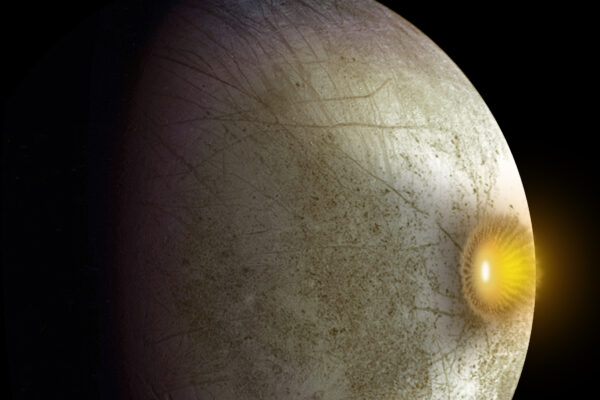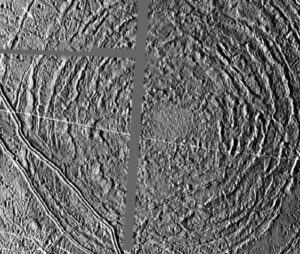Comet Impacts Could Bring Ingredients for Life to Europa’s Ocean
AUSTIN, Texas — Comet strikes on Jupiter’s moon Europa could help transport critical ingredients for life found on the moon’s surface to its hidden ocean of liquid water — even if the impacts don’t punch completely through the moon’s icy shell.
 An artist's concept of a comet or asteroid impact on Jupiter's moon Europa. Credit: NASA/JPL-Caltech
An artist's concept of a comet or asteroid impact on Jupiter's moon Europa. Credit: NASA/JPL-Caltech
AUSTIN, Texas — Comet strikes on Jupiter’s moon Europa could help transport critical ingredients for life found on the moon’s surface to its hidden ocean of liquid water — even if the impacts don’t punch completely through the moon’s icy shell.
The discovery comes from a study led by researchers at The University of Texas at Austin, where researchers developed a computer model to observe what happens after a comet or asteroid strikes the ice shell, which is estimated to be tens of kilometers thick.
The model shows that if an impact can make it at least halfway through the moon’s ice shell, the heated meltwater it generates will sink through the rest of the ice, bringing oxidants — a class of chemicals required for life — from the surface to the ocean, where they could help sustain any potential life in the sheltered waters.
The researchers compared the steady sinking of the massive melt chamber to a foundering ship.
“Once you get enough water, you’re just going to sink,” said lead author and doctoral student Evan Carnahan. “It’s like the Titanic times 10.”
Scientists have proposed impacts as a means to transport oxidants on Europa, but they assumed the strikes would have to break through the ice. This study is important because it suggests that a much larger range of impacts can do the job, said co-author Marc Hesse, a professor at the UT Jackson School of Geosciences Department of Geological Sciences.
“This increases the probability that you would have the necessary chemical ingredients for life,” said Hesse, who is also a faculty member at the UT Oden Institute for Computational Engineering & Sciences. The study was published in Geophysical Research Letters.
 A computer-generated simulation of the post-impact melt chamber of Manannan Crater, an impact crater on Europa. The simulation shows the melt water sinking to the ocean within several hundred years after impact. Credit: Carnahan et al.
A computer-generated simulation of the post-impact melt chamber of Manannan Crater, an impact crater on Europa. The simulation shows the melt water sinking to the ocean within several hundred years after impact. Credit: Carnahan et al.
Whether oxidants can get from where they naturally form on Europa’s surface to the ocean is one of the biggest questions in planetary science. One of the goals of NASA’s upcoming Europa Clipper mission to the icy moon is to collect data that can help narrow down answers.
For now, comet and asteroid impacts are among the most plausible mechanisms. Scientists have spotted dozens of craters on Europa’s surface, many with a distinct rippled appearance that suggests frozen meltwater and post-impact motion beneath the crater.
 Tyre, a large impact crater on Europa. Credit: NASA/JPL/DLR
Tyre, a large impact crater on Europa. Credit: NASA/JPL/DLR
This study models the crater environment after impact — investigating how meltwater travels through ice and its capacity for transporting oxidants. It builds on a previous study by co-author Rónadh Cox, a professor at Williams College, that modeled impacts breaking through Europa’s ice.
The study found that if an impact reaches the ice shell’s midpoint, over 40% of the meltwater will make it to the ocean. The volume of melt water generated can be significant. For example, this study showed that a half-mile-wide comet that reaches the ice shell’s midpoint would melt enough water to fill Oregon’s Crater Lake.
Other models describing meltwater on Europa often place it near the surface of the moon for long periods, where it could potentially contribute to icy formations called “chaos terrain.” But this study’s results complicate this idea, with the heavy weight of the meltwater causing it to sink rather than stay in place.
“We’re cautioning against the idea that you could maintain very large volumes of melt in the shallow subsurface without it sinking,” Carnahan said.
Like Europa, Saturn’s moon Titan may also hold an ocean of liquid water beneath an icy shell. Rosaly Lopes, the directorate scientist for the Planetary Science Directorate at NASA’s Jet Propulsion Laboratory (JPL), said that this model can help scientists understand the role impacts might have on other icy worlds.
“In the case of Titan, this is very important because Titan has a thick ice crust — thicker than Europa’s,” she said. “We’re really interested in the application of this study.”
Carnahan began the research during an internship at NASA JPL, working with co-author Steven Vance and completed it working with Hesse while earning his master’s degree. He is now a doctoral student at the UT Cockrell School of Engineering.
The UT Center for Planetary Systems Habitability, the Texas Space Grant Consortium Fellowship and NASA funded the research.
Publication: Rónadh Cox, et al., Impact breaching of Europa's ice: Constraints from numerical modeling, Advancing Earth and Space Science (2022). DOI: 10.1002/2015JE004877
Original Story Source: University of Texas

 Alerts Sign-up
Alerts Sign-up